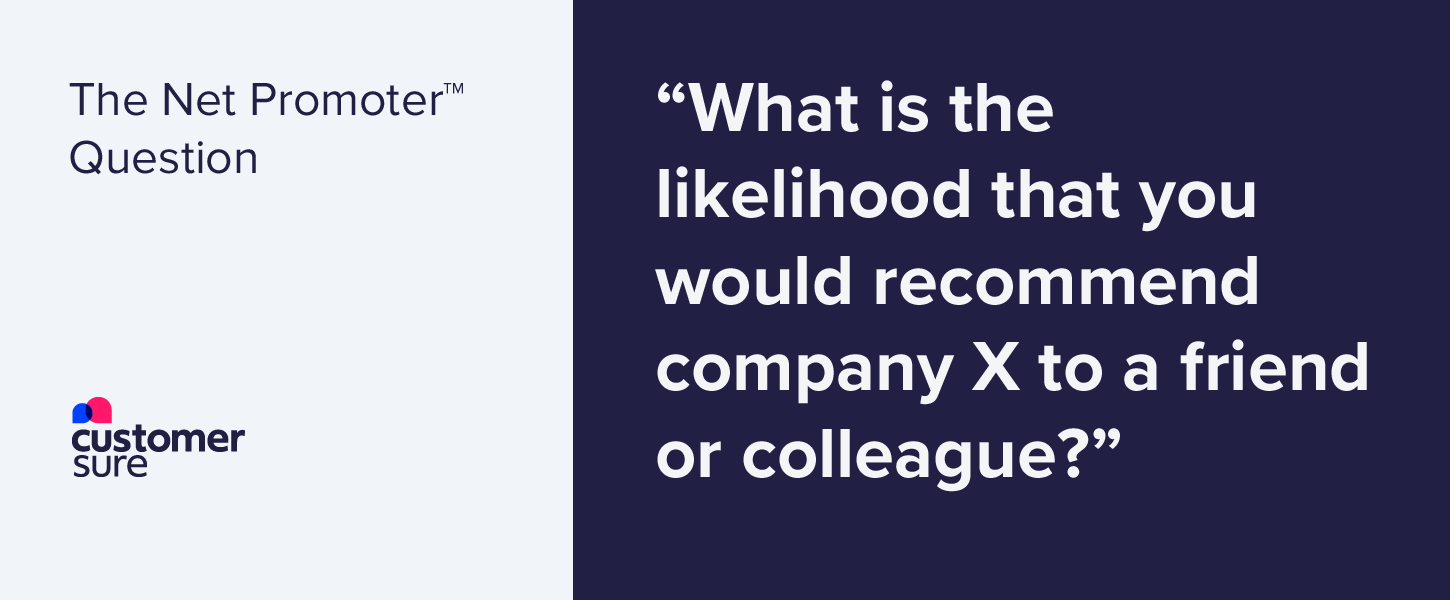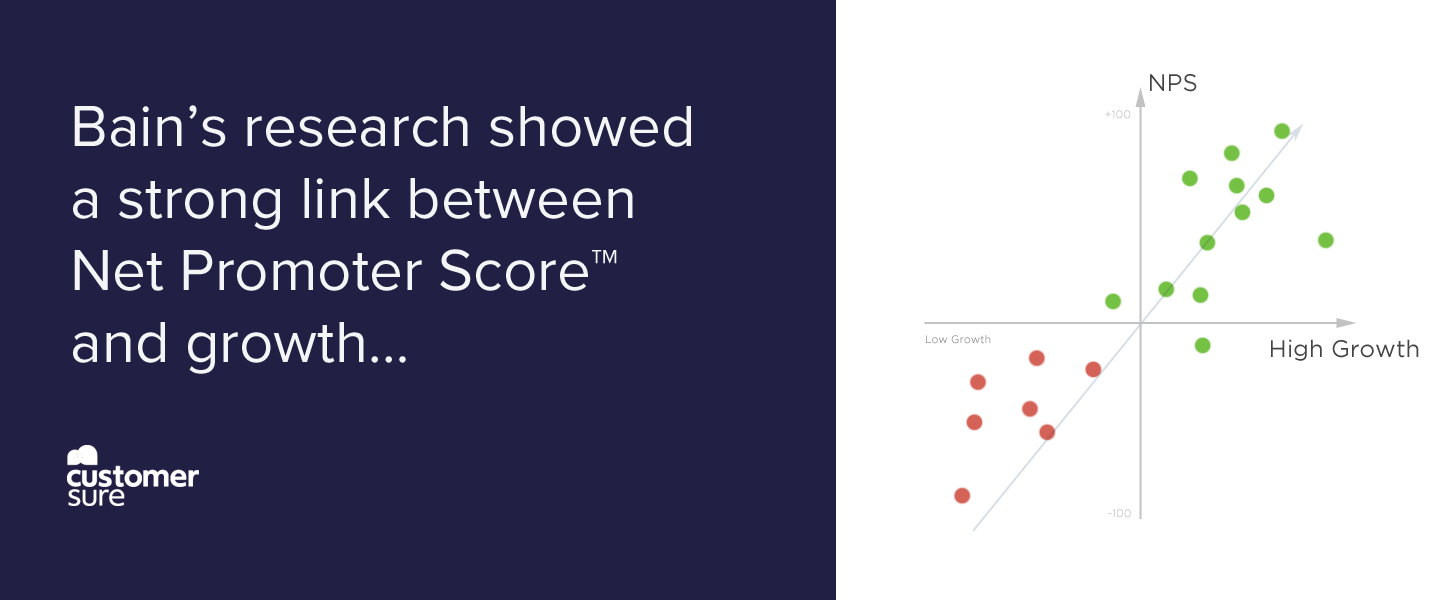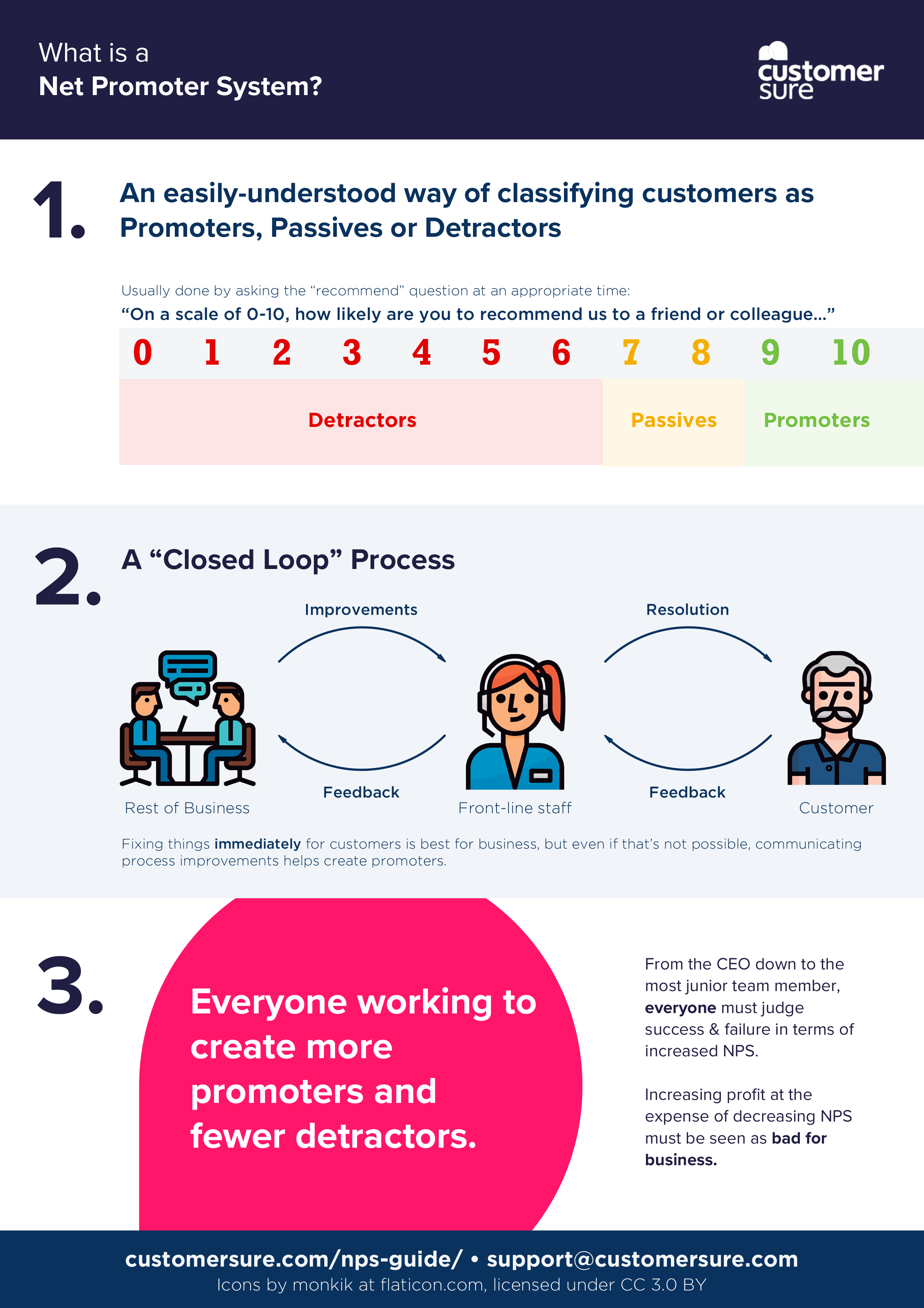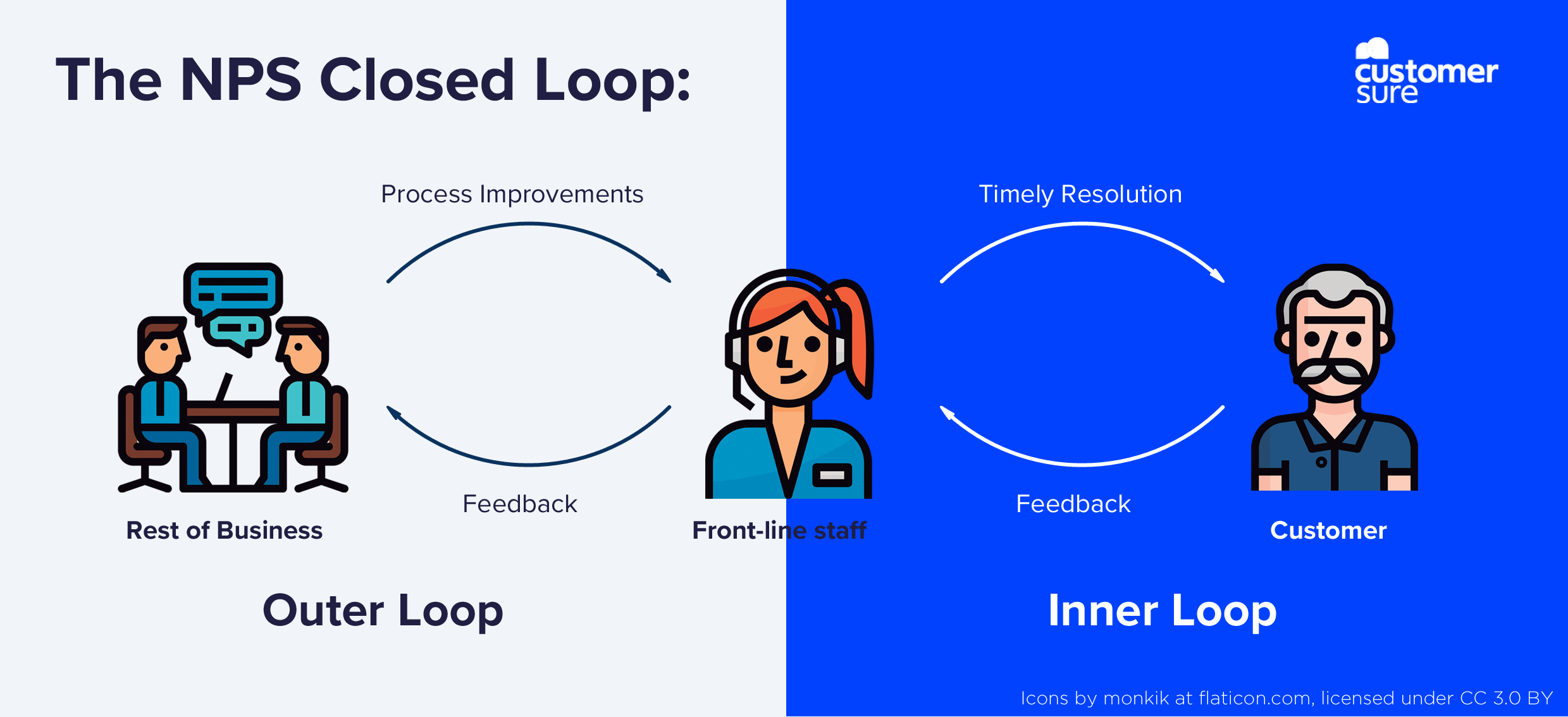

Net Promoter Score (NPS) is a CX metric, measured from -100 to +100 which measures how likely your customers are to recommend you. High NPS means your organisation is likely to grow, and low NPS means your organisation is at risk of losing customers.
It’s also the name of a systematic way of dealing with customer feedback to make sure the score heads in the right direction.
NPS isn’t the only CX metric, but it’s probably the most widely-used and understood.
But measuring your NPS alone isn’t helpful. Getting a number onto a MI dashboard isn’t going to retain a single customer, let alone drive up more pressing metrics like revenue and profit.
Fred Reichheld, the Bain consultant who gave NPS its name was well aware of this. That’s why he emphasised the need to systematically act on the customer feedback you receive along with the score.
It sounds like a no-brainer. But, it’s 2025, and customer service failures are costing UK organisations £7billion. So investing in getting it right is still a way to gain a competitive advantage.
Our CX platform and world-leading support have been helping teams implement NPS for 15 years, so if you’d like help getting set up, just get in touch. Or if you’d like to know more about NPS, read on…
NPS helpfully stands for two closely-related but slightly-different things:
The score is simple – it’s just a tiny bit of arithmetic on the answers to the Net Promoter Question.
But without the system, the score isn’t much use. It’s just a number.
There’s a short and long answer. In brief, the Net Promoter Question is:
“What is the likelihood that you would recommend us to a friend or colleague?”

It’s also called (obviously) the ‘recommend question’ and (less obviously) the ‘ultimate question’, because of the title of the book which first popularised Net Promoter.
But measuring loyalty doesn’t improve it.
And benchmarking loyalty against your competitors doesn’t improve it.
Taking action improves loyalty, and that’s what the Net Promoter System helps with.
Done right, the system works, because at its core it involves two things that actually make a difference to loyalty:
These two are so important, we consider them the golden rules of customer feedback.
To understand the Net Promoter System, it helps to know where it came from.
If you’re serious about implementing NPS, you should know why this question is the “ultimate question” – it wasn’t just plucked out of thin air.
In 2003, a consultant at Bain & Co. named Fred Reichheld started researching which customer satisfaction question was most strongly linked with growth.
His team compiled 14 success stories, where they compared responses to ‘customer satisfaction’ questions to actual, measured customer behaviour. The questions they tried were all derived from Reichheld’s earlier loyalty acid test.
In 11 of these success stories (78%), the NPS question was the most powerful at predicting future customer behaviour. In two of the remaining three studies, this question was second-best, but only by a hair’s breadth – it was almost as good as the top question.
Reichheld and his team then looked at the Net Promoter Scores of groups of competitors, and cross-referenced these scores with measures of how well these companies were growing. The results looked something like this:

What was the evidence telling them? Companies with high NPS scores are more likely to grow.
We’ve touched upon this already, but let’s make it clear:
Having a high Net Promoter Score is a sign that a company will grow.
But that doesn’t mean that getting a high Net Promoter Score is a business goal.
High NPS comes about when you’re a good business: One customers are likely to be loyal to. Measuring NPS fairly and accurately can tell you if what you’re doing elsewhere is working… But measuring NPS won’t turn you into a good business.
Net Promoter Score is the metric at the heart of the Net Promoter System.
When Fred Reichheld did the initial NPS research, he was already a senior consultant at Bain, helping corporate clients improve customer experience, and had quite literally written the book on loyalty.
Because he was already a trusted expert, the 2003 Harvard Business Review article which introduced NPS, “The One Number You Need To Grow” very quickly caught the imagination of influential CEOs.
His demonstration of a customer loyalty metric that was reliably linked to business growth was a glass of cold water in the desert to leaders who knew that loyalty was important, but struggled to improve it: It’s hard to improve what you can’t make people accountable for, and it’s hard to make people accountable for things you can’t measure.
So as these CEOs adopted NPS to measure their loyalty efforts, Reichheld curated a community of good practice around it – allowing these businesses to share good advice and learn from each other. This community helped establish the set of behaviours that we now know as the Net Promoter System – with the score at its heart.
The Net Promoter System is a way of focusing an organisation on doing work that improves customer loyalty.
By design, it’s a very ‘low ceremony’ system – there are no complicated spreadsheets, and only a minimal set of rules to define what is, and what isn’t NPS. It recognises that different things work for different people.
NPS says what you must do, but leaves a lot of the how up to you, as you know your business best. The three ‘unbreakable rules’ are as follows:
You must be able to categorise your customers into ‘promoters’, ‘passives’ and ‘detractors’, and calculate your score by subtracting your detractors from your promoters. Most commonly this is done by asking the ultimate question using a 0-10 scale, but you’re free to use other questions if they work better for your industry.
On the 0-10 scale, scores of 9 and 10 are considered promoters, 7 and 8 are considered, passives, and 0-6 are considered detractors.
You’re not required to use the 0-10 scale, but if you don’t, you need a sensible, standard way of defining these terms for other scales.
You must have a ‘closed loop’ process. That is, feedback should be shared directly with employees, employees must contact the customers who left feedback to address issues raised, and these issues should be shared in a systematic way with the rest of the organisation.
‘Success’ and ‘failure’ for the entire organisation must be framed in terms of increasing promoters and decreasing detractors. Of course, businesses will measure financial targets as well – but a successful business will only incentivise its staff to increase profit in ways that don’t hurt loyalty.
This is what Reicheld means when he discusses the idea of good and bad profits in the NPS book: Only organisations who chase ‘good profit’ — profit that doesn’t come at the expense of loyalty — succeed in the long run.

Although NPS is designed as a way of running an organisation, it’s still possible for teams that are passionate about great customer service to use the ideas of NPS in their own areas of influence. We often work with amazing teams who set an example to the rest of the organisation, and sooner or later the rest of the organisation catches on to the customer-centric secrets of their success.
If you want to know every single detail about NPS – where it comes from, how it works, and how to implement it, Fred Reichheld’s book is a brilliant read.
But if you just want to implement, or improve NPS in your organisation, based on advice from experts working ‘in the trenches’ with businesses like yours, talk to us or read the rest of our guides.
We’ll cover some of the key concepts like the closed loop, and then go into detail about how to calculate your NPS ways to improve NPS and why you shouldn’t waste your time on benchmarks
The tragedy of NPS is that, because everyone craves metrics, and the Net Promoter Score is a simple metric, very often we see organisations implement the score, and consider NPS ‘done’.
But as we’ve already said, just sending surveys and measuring this number does nothing to improve your bottom line. If the NPS book makes one thing clear, it’s this:
If companies who succeed with Net Promoter had to settle on the single most important key to meaningful progress, it might be this: building customer feedback into their regular daily operations and closing the loop by talking to individual customers and taking appropriate action.
– Fred Reichheld, The Ultimate Question 2.0
This ‘closed loop process’ consists of two parts:

Think about it:
As a customer, how do you feel when you need to give a company feedback but you just can’t get in touch? Worse, how do you feel when you give feedback, but never receive a response?
Implementing the ‘inner loop’ is the single most important investment you can make to improve customer satisfaction and loyalty. If you’re struggling to know where to begin, do this.
We’ve published an entire guide on how to be world-class at dealing with customer feedback, including:
When, and only when, you’ve closed the inner loop, you can look at building the outer loop. Your team will feel better because they know the wider business has got their back, and your customers will be delighted that you’re setting your roadmap based on their feedback.
Within the Net Promoter System, there are broadly two types of survey: (OK, there’s three, but we’ll come back to benchmarking later)
Because this is the practical guide to NPS, we’re going to cut to the chase and tell you that one of these surveys is vastly more important than the other:
If you want to use NPS to improve customer happiness, you should do transactional surveys
There’s a place for relationship surveys in a well-run business, but ultimately the difference is this:
A good relationship survey will tell you how happy your customers are, and show you some ways you can start making them happier.
If you’re lucky, the customers you surveyed will still be your customers by the time you roll out the improvements you’re making based on the survey results.
On the other hand, a good transactional survey, with a closed inner loop will make your customers happier. Instantly. Today.
So if your goal is happier customers, which are you going to do first?
Put yourself in your customers’ shoes (or just think about your relationship to companies that you do business with). Do you want to be a number on a spreadsheet which gets fed into a PowerPoint, which eventually leads to something, somewhere, maybe changing? Or do you want the chance to have your issues fixed?
In a perfect world, you should do both, but when we see relationship surveys recommended over transactional surveys, we see the cart being put before the horse – or rather measuring customer satisfaction being put before acting to improve it.
There are many criticisms of NPS – this article does a great job of listing a few and mitigating or debunking them.
But in general, criticism of NPS focuses on criticising the NPS question (i.e. it’s not a great question to ask), the NPS score (the scale is weird, the calculation is non-standard), or the comparison/benchmarking of NPS scores (we agree – don’t do it). The problem with all this criticism is… It largely misses the point.
Arguably there are better questions to ask, arguably different ways of calculating the score might yield better results, arguably you shouldn’t benchmark NPS. But none of that matters.
NPS is a means to an end, not an end goal. The goal is making your customers happier – because it’s the right thing to do, and because it leads to a more profitable business.
Remember, all a Net Promoter System is at its core:
It’s hard to criticise that.
The best way to make customers happy isn’t to debate different ways of calculating their happiness, it’s to roll your sleeves up, talk to them, and make them happy. It helps to have a metric to measure their happiness, and there’s a huge body of real-world success stories showing that the NPS question is a good way of doing this in a lot of industries, but if you object, or you find it’s not working for you, then you can change it for something that works better.
But first, listen to your customers.
Next time we send a newsletter, you’ll receive it.
We hope you love it, but if you don’t, it’s easy to unsubscribe.